Desertification: this serious silent problem
Elhuyar Fundazioa
A global problem
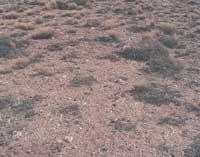
Desertification is destroying food production capacity in many large regions of the earth on all populated continents. Desertification does not occur in current deserts, which have no agricultural activity. On the contrary, it is happening in arid and semi-arid regions alongside the five great deserts of the world. These are:
- The desert of Sonora, in northwestern Mexico, and the desert region of southwestern United States, continuation of it.
- The Atakama desert, a narrow slope between the Andes and the Pacific.
- Great chain of deserts from the Atlantic Ocean to China: the Sahara desert, the Arabian desert, the ancient deserts of Iran and the Soviet Union, the Rajasthan desert in Pakistan and India and the deserts of Takla Makan and Gobi in China and Mongolia.
- South African Kalahari Desert.
- Most of Australia.
Percentage of deserts or lion lands on the total surface of the continent
Africa Asia Australia Europe North America South America Worldwide 66% 46% 75% 32% 34% 31% 41%
7% of the continental surface is desert and 35% dry land. In the world, land agriculture occupies a total area of 5.2 billion hectares, 69% of which are already damaged or at risk of desertification.
The loss of production caused by desertification in these territories, according to the United Nations, is US$42 billion annually (5,460,000,000,000 pesetas or 227,500,000,000 pounds). Moreover, between 1977 and 1988 some 10 billion dollars have been used in the fight against it. But that is not enough, because the phenomenon has not been stopped. Of the 99 affected states, 18 are industrialized.
They do not need external help to deal with the problem, but the remaining 81 do (including one of the poorest states in the world: Mali, Burkina Faso, Niger, Chad, Sudan, Ethiopia, Somalia). These poor states will have to invest between 800 and 2.4 billion dollars annually, according to the UN, in forecasting measures, more than 1,000 to 3 billion dollars annually in corrective measures, more than 2,400 to 3 billion dollars annually to rehabilitate the affected territories of the year.
Deserts and lion lands
Continent Africa Asia Australia Europe North America South (million hectares) 672 277 0 3 26Total dry agricultural land (million hectares) 1433 1881 701 146 578 421Already degraded agricultural land 73% 70% 54% 74% 72%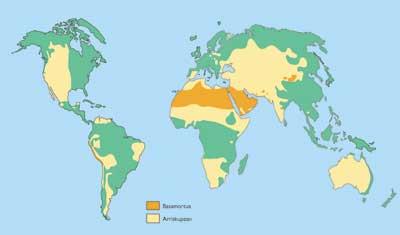
Desertification, poverty and war
Until recently poverty and desertification were never linked, but today most experts agree that both phenomena are related. As the population grows, farmers in poor countries do not have the means to increase their production without damaging rainfed lands. They are required to increase crops for export and impoverish the land. The relationship between desertification and underdevelopment is very clear in Sudan and the Sahel region, a dry region that runs from east to west Africa.
There are many of the poorest states in the world. Desertification and land degradation only help social and political conflicts, as evidenced by the wars of the 70s, 80s and this decade in the Sahara and the Horn of Africa. Although in the previous two decades the Cold War contributed an ideological component to the problem, in this decade the problem is appearing in its purest form.
Losses from desertification by continents
Asia Africa North America Australia South America Europe TOTAL
21.000 9.000 5.000 3.000 3.000 1.000 42.000What is desertification?
Between 1968 and 73 the terrible drought affected the African region of the Sahel, killing hundreds of thousands of people and animals. It was then that he began to seriously study desertification. Since 1977, anti-desertification programmes were launched and millions of dollars were allocated in Sahel, but the results have been mediocre. 20 years ago desertification is a bigger and more complex problem than expected.

The very definition of the problem has undergone changes. In 1991 the United Nations Environment Organization Programme proposed defining desertification as a result of human impact, but some States called for “easing” the definition. Consequently, a new definition was agreed at the international meeting on the environment held in Rio de Janeiro in 1992, reducing the importance of human impact: desertification is a “degradation of land in arid, semi-arid or dry sub-humid regions, caused by climate change or human activity”. But the debate is not over.
Several experts have proposed to dispense with the term “desertification” in territories where different processes converge, since these must be separated and analyzed individually. For example, the definition of desertification includes land salinization caused by irrigation systems, a problem that has nothing to do with soil erosion in drylands.
The meaning of the term has been broadened, which was formerly a problem of arid and semi-arid regions, and is now also used to call degradation problems of subhumid regions. On the other hand, other experts, following this disorder of definitions, observe the trick made by States that have their territory at risk of desertification to obtain international aid. Despite the definitions, three different processes must be distinguished:
- drought: a period of one year or two years in which the number of precipitation falls is significantly lower than the average.
- Depletion: Dewatering process that lasts decades.
- Dry soil degradation: decreased soil productivity due to the use of incorrect tillage techniques in unfavorable environmental conditions.
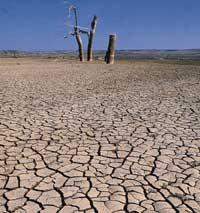
These three processes can be analyzed one by one, using different policies of struggle against each of them. Access to food for the local population is a priority in the drought-affected area. To cope with exhaustion it is necessary to implement adaptation programs that allow the development of livestock and agriculture in drier conditions. Finally, the legislative changes that will affect land ownership against the degradation of dry soils, as well as the development of adequate means for the maintenance and containment of water in the basins.
The desert does not expand
The idea of the “invading desert” is totally wrong. The desert does not expand, the dunes are not covering the surrounding territories. It is true that the desert "expands" if it occurs a dry year, but the following year it will "contract" if the rainy year coincides. These desert movements are cyclical and should not be confused with desertification. Desertification means the emergence of conditions for drylands to become deserts.
Causes of desertification

Four are the culprits of desertification: deforestation (which is the most well-known case and we will not explain here), excess cultivation, excess grazing and poor irrigation. Population growth, climate change and change in economic and social conditions aggravate these four phenomena.
- Excessive cultivation: as the population increases more food is needed. On the other hand, in States with foreign debt, rapid growth plants and intensive cultivation are prioritized for export. For example, in West Africa, since the 1960s, peanut production increased dramatically, resulting in soil degradation. Pastures for livestock use are used for agriculture, reducing livestock areas and increasing soil erosion. Excessive cultivation creates conditions that will open the door to desertification: it reduces soil fertility and crop productivity, leaving the high surface of the soil subject to rain, winds and sun attacks.
- Overgrazing: it is also a consequence of population growth. On the one hand, the agricultural area is growing. On the other hand, farms are getting bigger, with pastures and espadrilles getting smaller. Livestock contributes to desertification by reducing the production of grass plants and reducing edible herbs (especially perennials that support the soil). In turn, the soil is compacted, as farms pisan when concentrated in the territories near lakes and pastures.In arid and semi-arid regions there are three types of grazing: nomadic, sedentary and farm. According to experts, the nomad is the one who best uses the land, since at the end of the wet season and at the beginning of the dry season, the animals are dragged from the arid regions to the semi-arid territories. Sedentary grazing takes advantage of the pastures around small villages. Always use the same eaves, exploiting them intensively and degrading the soil. Finally, grazing on large livestock farms is used in the developed States, especially in the United States and Australia. More than half of US private livestock farms produce half or less of their potential due to soil erosion and overgrazing. A study conducted in 1970 in western Australia revealed that a region of 40,000 km2, after 60 years of intensive sheep stay, 15% of its territory was so degraded and eroded that it was wasted for livestock.
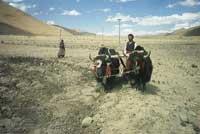 To cope with exhaustion it is necessary to implement adaptation programs that allow the development of livestock and agriculture in drier conditions.
To cope with exhaustion it is necessary to implement adaptation programs that allow the development of livestock and agriculture in drier conditions. - Irrigation: it is considered an excellent solution to increase food production in arid regions, and it is true that thanks to it has increased the production of cereals and other plants. However, if not properly designed and maintained, irrigation can turn the territory into desert. The data are surprising: taking into account arid regions around the world, 500,000 hectares are converted every year into desert irrigated areas (approximately the same area of land where irrigation comes every year for the first time).
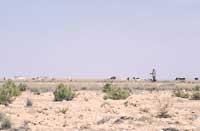
In order not to properly drain the irrigated territory, the soil will lighten first and the salts will be deposited on the surface of the soil. Half of the crop irrigation that has become deserts in the world are found in South Asia, especially in India and Pakistan. 20% of watered territory in India is affected by salinity. Following the construction of the Asuan dam in Egypt in 1960, irrigated territory increased by 500,000 hectares and increased food production. However, at present 28% of irrigated territory is salty and cleared and the harvest is declining.
Is there a solution to problems?
In 1978, the United Nations created a desertification control programme, supported States in developing anti-desertification plans, encouraged the support of the international community and developed a methodology for coordination, advice and cooperation among national, regional and international institutions. The retrospective analysis carried out in 1990 showed that the basis of the programme was adequate, but it was attributed to the programme that local socio-economic factors had not been taken into account and that there had been less human resources than necessary.

Other international organizations created in Africa to combat desertification are: United Nations Sudano-Sahelian Office (UNSO), founded in 1973; Comite Inter-Etats de Lutte contre la Secheresse au Sahel (CILSS), founded also in 1973; Inter-Governmental Authority on Drought and Desertification, Saharatory, 1990. These entities have launched several programs, but have often competed jointly for international grants. At the state level, several institutions have also been created that design plans to address the problem. But many times plans have been happening, without measuring costs and resources well or analyzing results. In addition, coordination between plans has often failed.
Today all experts agree that the participation of the population of the region in danger is essential to face the problem. Until recently it has been considered that traditional cultivation and grazing adversely affected dry land. However, studies have shown that traditional actions are more appropriate than expected and that efforts are focusing on the assumption of the local population and the transfer of management and responsibility of the plan. There have been numerous successful initiatives in this field.

For example, some cities in Burkina Faso and Niger have surrounded themselves with trees capable of withstanding drought. These green belts protect cities from sand dunes and strong winds, in addition to providing shade and using their wood as fuel or as building material, that is, to meet the needs of the local population.
However, in short, the problem is economic. At the 1992 Earth Summit in Rio de Janeiro, it was decided to address the problem, but it does not seem that the rich states of the world intend to move quickly.





